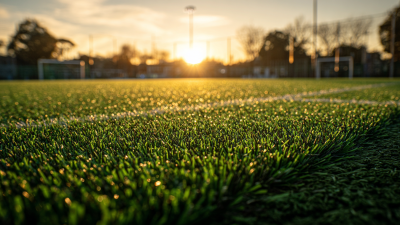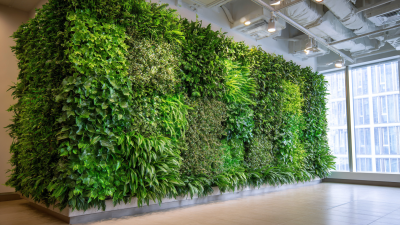Choosing the right plastic grass for your landscaping needs is a decision that combines both durability and aesthetic appeal. According to a report by the Synthetic Turf Council, the synthetic turf industry has seen a steady growth rate of 10% annually, indicating a growing acceptance of plastic grass among homeowners and businesses alike.

This rise can be attributed to advancements in technology that have improved both the look and longevity of artificial grass. For instance, modern plastic grass options are designed to withstand varying weather conditions, with some products boasting a lifespan of over 15 years, making them a cost-effective alternative to natural grass. As landscaping trends continue to emphasize sustainability and low maintenance, understanding the features of different plastic grass products is essential for making an informed choice that complements your outdoor space.
When selecting plastic grass for landscaping, understanding the various types available is crucial. Synthetic turf comes in numerous styles, textures, and colors, designed to cater to different aesthetic preferences and functional requirements. For instance, some products mimic the look of natural grass with varying blade heights and thicknesses, while others offer unique colors to suit modern landscaping themes. Knowing the difference between polyurethane, polyethylene, and nylon fibers can help you make an informed choice, as each material varies in durability, UV resistance, and overall appearance.
In addition to material differences, it’s essential to consider the intended use of the plastic grass. For high-traffic areas, a denser, more durable option may be necessary to withstand the wear and tear from foot traffic, pets, or recreational activities. On the other hand, for decorative purposes or low-usage spaces, a softer, more aesthetic option might suffice. By evaluating the specific needs of your landscaping project while taking into account the range of synthetic grass types available, you can create an appealing and functional outdoor space that meets your durability and visual expectations.
When selecting the right plastic grass for your landscaping needs, durability is a crucial factor that should not be overlooked. The longevity of artificial grass can significantly affect your overall satisfaction with your yard. Important aspects to consider include the quality of materials used, UV resistance, and the type of backing. Higher-quality grass often comes with better warranties, which can be indicative of its ability to withstand wear and tear. Additionally, consider how the grass will hold up against common activities in your yard, such as foot traffic and pet usage.
Tips: Always check for a product’s ratings regarding durability and ask for samples if possible. Comparing multiple brands can help you understand which products stand out in terms of robustness. Furthermore, examine customer reviews for insight on performance over time.
Another key aspect is the aesthetic appeal of the grass. Choose a color and texture that complements your landscape design. Some products mimic the appearance of natural grass closely, making them ideal for residential lawns, while others may offer unique colors perfect for themed gardens or play areas. The right choice should enhance your outdoor space, offering both beauty and function.
Tips: View grass in natural light before making a purchase to see how it truly looks against your existing landscape. Consider how the grass will blend with surrounding plants and features to create a harmonious look.

When it comes to enhancing curb appeal, choosing the right plastic grass can transform your landscaping into a stunning oasis. The aesthetic options available today cater to diverse styles, allowing homeowners to select a look that complements their unique taste and architecture. From lush, vibrant greens to more subdued earth tones, the variety of colors and textures in artificial grass can be tailored to suit any landscape design, ensuring a seamless integration with surrounding plants and features.
Incorporating plastic grass into your landscaping not only adds visual interest but also provides a low-maintenance solution that remains attractive year-round. With advancements in technology, modern synthetic grass mimics the look and feel of natural grass, making it an appealing option for homeowners looking to enhance their outdoor space. Additionally, options that replicate various grass types allow for creative landscaping designs, whether you're aiming for a manicured lawn, a rustic garden, or an elegant pathway. By selecting the right plastic grass, you can achieve a polished and inviting look that significantly boosts your home's curb appeal.
| Feature | Synthetic Grass Type | Durability (Years) | Aesthetic Appeal (1-10) | Maintenance Level (Low/Medium/High) |
|---|---|---|---|---|
| Nylon | Premium Grade | 15-20 | 9 | Medium |
| Polyethylene | Mid-Range | 8-15 | 8 | Low |
| Polypropylene | Budget Option | 5-10 | 6 | High |
| PP Blend | Eco-Friendly | 10-12 | 7 | Medium |
| Athletic Turf | Sport Grade | 10-15 | 8 | Low |
Maintaining plastic grass to keep it looking fresh and inviting requires regular attention and a few straightforward strategies. Start with routine cleaning to prevent debris buildup. A simple weekly rinse with a hose can wash away dirt, leaves, and dust. Use a broom or a leaf blower to remove larger debris, ensuring that your lawn remains neat and appealing. For more stubborn stains or spills, a mixture of mild soap and water can effectively lift discoloration without damaging the grass fibers.

Another important aspect of maintenance is brushing the grass regularly. This helps to keep the blades upright and enhances the aesthetic appeal of your landscaping. A stiff-bristle broom or a specialized turf rake can be employed to fluff up the grass and maintain its natural appearance. It is also essential to check for any signs of wear or damage, particularly in high-traffic areas. Promptly addressing any issues will prolong the lifespan of your plastic grass and ensure it continues to provide an attractive and functional landscape all year round.
When considering the purchase of plastic grass for landscaping, cost analysis becomes vital for determining the best value within your budget. According to a report by the Synthetic Turf Council, the average cost of high-quality artificial turf can range from $5 to $20 per square foot, depending on the material and installation complexity. While initial investment may seem steep, it's essential to factor in the longevity and maintenance savings that come with these products. Many synthetic turf options come with warranties ranging from 8 to 15 years, significantly reducing the costs associated with mowing, watering, and fertilization that natural grass demands.
Moreover, newer technologies in the plastic grass market have led to improved durability and visual appeal, impacting overall value. Data from a recent market analysis reveals that premium synthetic turf options offer a return on investment (ROI) of approximately 60-70% when audited against the costs of upkeep for natural grass. Furthermore, eco-friendly choices like infill made from recycled materials not only appeal aesthetically but also provide an economical alternative without compromising quality or environmental standards, making them an attractive option for budget-conscious homeowners.












